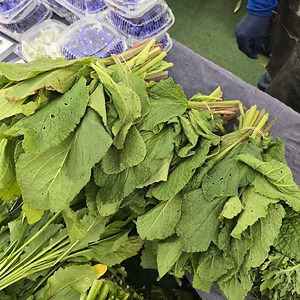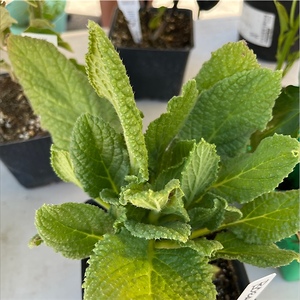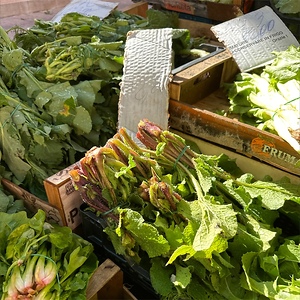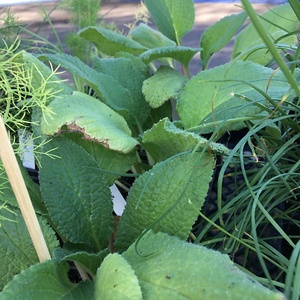


Borage Leaves
Estimated Inventory, lb : 0
Description/Taste
Borage leaves are variable in size, depending on maturity and growing conditions, and can average between 5 to 30 centimeters in length. The leaves have a broad, oval, and slightly frilled shape, connecting to long, slender stems arising from a single base. The leaves are typically dark green and have a crinkled, textured surface with coarse veining. The edges are serrated and sometimes flushed with white or yellow spots. The pale green to red stems are hollow, snappy, fleshy, and lightly firm. It is important to note that Borage leaves, flowers, and stems are covered in fine white-grey bristles, also known as trichomes, that appear like small hairs. These bristles become sharper and pricklier with maturity, so care should be taken when handling the plants. Borage leaves are edible raw when very young, but most preparations call for cooking the leaves and stems to remove the irritating hairs. The leaves and stems have a crisp, subtly chewy, and tender consistency once cooked, releasing a vegetal, grassy aroma. Borage leaves are known for having a distinct herbal, cucumber-like, green taste combined with subtle briny nuances. The blue-to-white, five-petaled, pointed flowers are also edible raw and have a mild, subtly sweet, honey-like taste.
Seasons/Availability
Borage leaves are available year-round, with a peak season in the spring through early summer.
Current Facts
Borage, botanically classified as Borago officinalis, is an annual herbaceous species belonging to the Boraginaceae family. The leafy plants are fast-growing, reaching up to one meter in height, and are self-seeding, producing multiple plants in the same location for several years if left uninterrupted. Historically, Borage has been known as a medicinal and culinary plant, and most of the plant is edible, including the leaves, flowers, and stems. The plants are known by several names worldwide, including Bee Plant, Starflower, Bugloss, Bee Bush, Bee Bread, and Bee Flower. Borage has remained primarily wild, but the species has been selected over time as a home garden plant, especially throughout Europe and parts of North America. Consumers value Borage leaves and flowers for their ornamental, culinary, and medicinal uses, and they are versatile, incorporated into a wide array of sweet and savory preparations.
Nutritional Value
Borage leaves are a source of vitamin C to boost the immune system, vitamin A to maintain healthy organ functioning, and potassium to balance fluid levels within the body. The leaves also provide iron to develop the protein hemoglobin for oxygen transport through the bloodstream, magnesium to control nerve functions, calcium to build strong bones and teeth, and other nutrients, including zinc, manganese, copper, and B vitamins. In natural medicines, especially throughout Europe, Borage leaves have been viewed as an ingredient to purify and detox the body by stimulating the action of sweating. The leaves also have anti-inflammatory properties and are traditionally steeped into a tea to lower fevers and lessen coughs. The stems and leaves contain mucilage, allowing them to be crushed and topically applied over skin irritations. Oil from Borage seeds is also seen as an anti-inflammatory and is sometimes taken to help lower blood pressure.
Applications
Borage leaves have a mild, green, cucumber-like taste suited for cooked preparations. Young greens are technically edible when raw, but most consumers cook the leaves to soften their texture and remove the prickly hairs from the surface. These hairs can sometimes cause irritation, especially on mature leaves, but they are easily removed when washed and boiled, sauteed, steamed, or fried. Borage leaves can be washed in water with bicarbonate to act as an antibacterial, and once cleaned, the leaves can be quickly sauteed or boiled like spinach and served as a side dish. Borage leaves can also be battered and fried, simmered into soups such as minestrone, spring vegetable, or legume-based recipes, and the greens develop a tender consistency for use in omelets. Try combining cooked Borage leaves with cheeses in savory pie fillings or cooking in herbs, anchovies, and aromatics as a simple side. The leaves can also be boiled and stirred into dips or blanched, filled with cheese, rolled in breadcrumbs, and baked. Borage is noted for its zero-waste nature. The leaves, flowers, and stems are edible, and the flowers and young leaves can be used as a fresh garnish for cocktails, desserts, and lemonades. The flowers are also popularly frozen into ice cubes as a festive addition. In Germany, Borage leaves are used in Frankfurt to make grüne soße, a traditional and well-known green herb sauce, and is often served with eggs, on bread, or with apple cider. In Liguria, Italy, the leaves are used as filling for ravioli, risotto, and the traditional Ligurian walnut pasta dish pansotti. In addition to the leaves, Borage flowers have a mild, sweet taste sprinkled over dishes as a fresh edible garnish. The flowers can be tossed into salads, fried as a bite-sized appetizer, or displayed on pastries. The flowers are also candied for desserts or floated on top of beverages. Borage leaves pair well with cheeses such as mozzarella, ricotta, and gorgonzola, asparagus, mushrooms, peas, herbs including basil, mint, dill, and lavender, nuts such as pine, almonds, and walnuts, and aromatics including garlic, ginger, shallots, and onions. Borage leaves and flowers should be immediately used after harvest for the best quality and flavor. The leaves will keep for a couple of days when stored unwashed in a sealed container in the refrigerator.
Ethnic/Cultural Info
In Ancient Greek and Roman folklore, Borage was viewed as a plant that inspired courage and acted as a remedy for feelings of sadness. Pliny the Elder, a Roman naturalist, hypothesized that the Nepenthe mentioned in Homer’s Odyssey was a mixture of Borage and wine. Nepenthe was a mythical substance recorded in the Odyssey that was said to “chase away sorrow.” Pliny also mentioned Borage as a natural anti-depressant and was sometimes given to patients dealing with melancholy or depression. Among cultural lore, available women would slip Borage flowers into the wine of male suitors. This mixture was thought to boost the man’s courage and encourage him to ask for her hand in marriage. While many of these claims are simply superstitions and myths, Borage has maintained the reputation of being a joyful plant across Europe and is viewed as a positive species in meadows, home gardens, and along roadsides.
Geography/History
Borage is native to the Mediterranean and was thought to have originated near or in Syria. The species has been growing wild since ancient times and remained primarily a foraged species for medicinal uses. Borage eventually spread west across the Mediterranean in the early ages and expanded into Northern Africa and Asia due to human intervention and natural occurrences. Several written texts mention the use of Borage leaves and flowers throughout history, and over time, the species was selected as a home garden plant for cultivation, expanding worldwide. Borage seeds were brought with European immigrants to the New World in the 17th century and were planted in home gardens. The plants later escaped cultivation and became naturalized along the east coast of the United States. Today, Borage thrives in woodlands, pastures, fields, on disturbed or cultivated land, and abandoned plots. The species is also planted in home gardens and is a favorite of beekeepers, as the flowers attract pollinators for increased honey production. Borage plants are found wild, naturalized, and cultivated throughout Europe, Asia, North America, New Zealand, Australia, and South America. The Borage leaves featured in the photograph above were sourced through a local market in Marsala, Sicily.
Recipe Ideas
Recipes that include Borage Leaves. One











